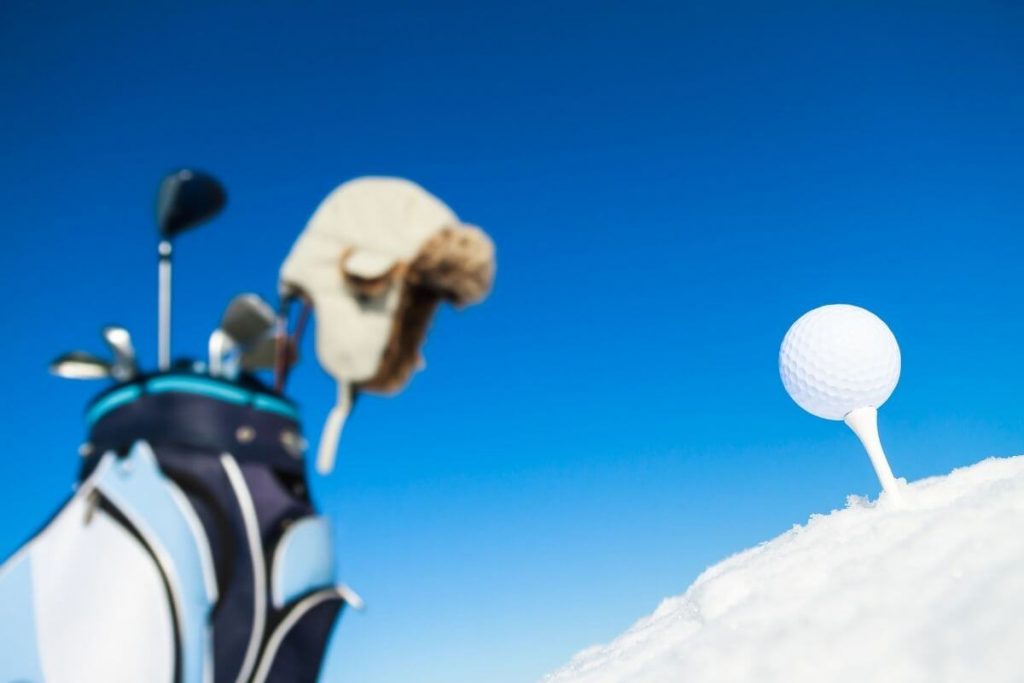For some people, playing golf in the winter is most enjoyable as the golf courses are more quiet and the prices fall during this time.
On the other hand, golfing in the cold can be tough as the courses become damp, the temperatures fall and players will need to wear layers of clothing with their hands potentially freezing off. (Brr..)
Given these severe cold conditions, many golfers want to know if their golf clubs can be stored in the cold? Would it damage or affect the performance of the club? I decided to do a little research and here is what I found:
Table of Contents
Can Golf Clubs Be Stored In The Cold
Golf clubs should not be stored in the cold, especially not outside during the winter as such temperatures can cause the grips to dry out and even crack. As a rule of thumb, your clubs should be stored at temperatures between 40 and 80 degrees Fahrenheit.
When your clubs are exposed to cold temperatures for too long, the moisture may cause the grips to go white and become brittle. This makes it more prone to breaking off from the club’s shaft.
If your grips come in contact with moisture from the cold, you should wipe it down with a towel as soon as possible. This will prevent the grips from absorbing moisture. We recommend using gloves as well so you don’t leave back any water droplets.
Leaving your golf club outside in the cold will increase the build up of condensation. This can cause the metal parts to rust and create cracks in the shaft when left out for long periods of time.
So where should you store your golf club during the winter?
Some people suggest storing it in the garage, but it turns out that this is not a good idea as the garage isn’t climate controlled.
The best and simplest place to store your golf clubs during the cold is in your house; specifically your closet or a corner inside your house. Also, if you have a climate-controlled storage unit, then that would be a great place to store your clubs.
The purpose of a climate controlled storage unit is to take the edge off of outside temperatures. This is accomplished thanks to the air system that triggers when temperatures get unpleasant.
If you don’t have a climate controlled storage unit, then you may think of buying one for storing your golf clubs. The monthly price usually cost between $75 to $225.
But, if you can’t afford the monthly cost during the winter season, then your best option is to store the clubs in a corner of your home or closet.
Cold Vs Heat: Which Is Worse For Your Clubs?
If you live in an area with cold weather, you should know that lower temperatures aren’t as damaging as heat.
The heat is quicker to breakdown the epoxy and glue that joins the clubhead and shaft. This causes the grip to slip around the shaft.
The heat weakens the glue and causes the clubhead to loosen and potentially fall off the shaft.
The epoxy of the shaft begins to breakdown at 250 degrees Fahrenheit. Once the epoxy bond is broken, the head can be pulled off.
Heat also deteriorates the club grip and makes it hard. Therefore, It is not ideal to leave your club in the trunk of your car as temperatures may go as high as 200 degrees on sunny days. And, as we have mentioned before, such temperatures will cause the epoxy that affixes the clubhead onto the shaft to breakdown over time.
If you must leave your golf clubs in the car in warm weather, ensure that it is not placed anywhere in the trunk and that you are parked in a shaded area with your windows slightly opened so that heat can escape.
How Does Cold Weather Affect Your Golf Club Swing
Cold weathers can negatively affect your game. For example, in the winter, you won’t be able to turn as far or swing your clubs hard enough.
Cold air is denser than warm air. Due to the density of cold air , this allows for additional drag force on the ball which will slow it down.
You can expect your swing speed to fall when it’s cold, thereby causing the ball to lose distance when you hit it. This is because it is harder to warm up properly in the cold than say in the hot summer days.
Your golf equipment such as your clubs and irons will work better in warmer conditions as the cold tend to decrease the elasticity of the metals in your clubs.
What does this do? Well it results in less efficient energy transfer to your golf ball that would negatively affect the distance it travels. So, in colder conditions the ball will travel less, but in warmer conditions the ball will travel farther as there is more energy transfer to the ball when the weather is warm.
Therefore, it is important to keep your club in a dry and warm area in order to maintain it’s performance.
Below I’ve put together a table showing the distance of your golf clubs in different temperatures. This will help you to get an understanding of how far you can expect the ball to travel in different climates.
Table Showing Golf Club Distance In Different Weather Conditions
| Temperature (Fahrenheit) | Driver (yards) | 4-iron (yards) | 7-iron (yards) | PW (yards) |
| 30° | 242.4 | 182.8 | 152.8 | 122.8 |
| 40° | 244.3 | 184.6 | 154.6 | 124.6 |
| 50° | 246.2 | 186.4 | 156.4 | 126.4 |
| 60° | 248.1 | 188.2 | 158.2 | 128.2 |
| 70° | 250 | 190 | 160 | 130 |
| 80° | 251.9 | 191.8 | 161.7 | 131.3 |
| 90° | 253.8 | 193.6 | 163.4 | 132.6 |
| 100° | 255.7 | 195.4 | 165.1 | 133.9 |
| 110° | 257.6 | 197.2 | 166.8 | 135.2 |
Storing Your Golf Clubs In Your Bag

When storing your golf clubs, you need to properly pack them in your golf bag. Golf bags have a built-in stand mechanism and are created for players who wish to have their clubs with them while walking the golf course.
Your golf bag should have the basic clubs and irons such as the driver, 3 wood and 5 wood, 3-iron, 9-iron, sand wedge, pitching wedge and putter.
Golf bags are needed for practically anyone who is interested in playing the game and they have enough storage to carry almost everything you need to play a 18 hole round of golf.
The question I get a lot is how to actually pack and arrange the clubs in your bag?
You want to ensure that the clubs are organized properly in your golf bag as this would help to facilitate quick retrieval and return of the clubs when you are on the course playing. This will positively impact the pace of your game.
Note that all golf bags are not the same as your strategy for organizing the clubs will be dependent on the type of bag you are using.
Here are some tips that will help you properly arrange the clubs in your bag:
1. First identify the type of bag you are using. Golf bags come in different partitions having 2,3,4,5 and even 6 partitions. Arranging the bag will be easier if you understand the bag and it’s different compartments.
2. Find the longest club in your arsenal (typically the driver) and put it in the back part of your bag so that it’s close to the strap.
3. Golf clubs should be organized from left to right.
4. Once you have packed your longest club, arrange the irons in the next row. The longest irons should be placed on the left and the shorter ones to the right. The front part of your bag should facilitate the smaller sized clubs such as the wedges.
5. Some bags will come with a section for your putter to go in. If this section is absent from your golf bag, you can place it in any row usually to the right side as the putter is smaller in length.
6. Your next items will be your golf tees and golf balls. Most golf bags have partitions to store your tees in and pockets to store your balls.
7. Finally, there is an additional pocket on your golf bag that sticks out on the right side. This can be used to store your clothing.
Final Verdict
Keeping your golf clubs safe in a warm and dry area is the best thing to do when you are experiencing cold conditions in the winter season.
Constant exposure to such conditions won’t necessarily damage shaft or clubhead. It will however cause them to harden or crack. It’s always best to keep your clubs in dry temperature controlled conditions like the closet in your home or a climate controlled storage unit.
Not only do your clubs need to stay dry and warm, but your entire body as well. Having cold hands will cause you to lose the ability to feel small vibrations when you hit your golf club.
Moreover, if your hands are freezing off, you wont be able to properly grip the club to make that perfect shot. Such small nuances can impact the control you have when hitting the club.
All in all, the conditions in the winter will be tough, but it is a great opportunity to hone your shot making skills as you will tend to get creative with your shots as you battle the elements. Therefore, when winter is over, you will be much well rounded and playing like a pro when spring comes.



